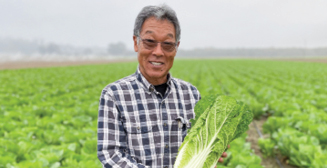From the Fields - Tom Ikeda

Photo/Aubrey Aquino
By Tom Ikeda, San Luis Obispo County vegetable grower
The temperature along the coast has stayed fairly steady. We go up into the low 80s occasionally, but we haven’t had those hot spikes into the 90s that not only affect crop growth but also bring a lot of insect and disease pressure. Because of the mild temperatures throughout the summer in all regions, we had good growing conditions. We had some humid weeks, so mildew has been a problem on lettuce, but we had very few issues. Last week, we started planting vegetables that we grow year-round. We won’t harvest those until after the new year. We also wrapped up our last plantings for the holiday markets.
This time of year, there is usually a drop in market prices because fall weather is so variable. With the mild conditions, there’s a lot of supply out there without any natural gleaning, either due to weather or insects to reduce some supply. With the good growing conditions, we didn’t see the spikes in markets that we were thinking. Lettuce prices are pretty cheap, and cilantro had a little bit of a spike, but not that big of a spike. For Asian vegetables, we’re pretty much dragging the bottom of the barrel as far as price goes.
We are trying to figure out plans for our off season or our slow time of the year. We are trying to figure out how to prepare and plan for contingencies if we have a wet, warm El Niño winter, and if we don’t. A wet El Niño causes delays in all growing regions, so it creates a situation where there could be a supply shortage. Knowing how to adjust could bring opportunities, so we must figure out how to maximize our potential for reaping those opportunities. We need to know how a wet winter will affect the markets, and if we don’t have a wet winter and everybody is able to plant, how should we adjust?




